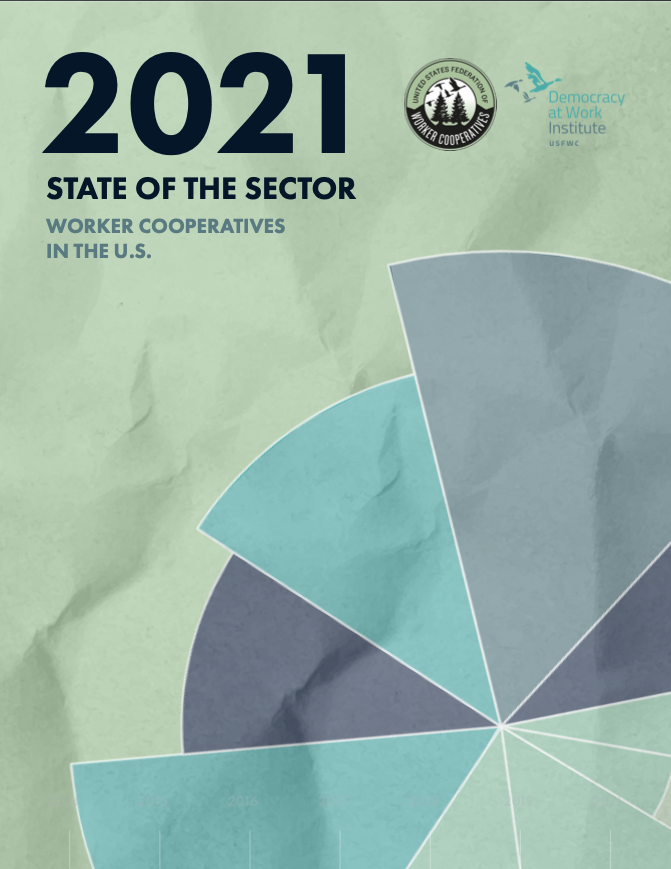Bi-annual census shows growing number of regions where worker co-ops flourishing
by Karen Kahn

The number of worker cooperatives in the United States grew more than 30 percent since 2019, an astonishing figure when you consider the obstacles to new businesses during the pandemic. Through its bi-annual economic census completed in 2021, the Democracy at Work Institute (DAWI) verified 612 worker cooperatives employing 5,966 workers.
In 2019, DAWI identified 465 worker co-ops employing 6,454 workers. The worker co-ops verified in the census must have at least three workers and 50 percent ownership of the business. DAWI estimates that there are closer to 1,000 worker co-ops operating in the U.S., with 10,000 workers.
In its bi-annual economic census, Democracy at Work Institute verified 612 worker cooperatives employing 4,732 workers.
The 2021 State of the Sector report, published in collaboration with the U.S. Federation of Worker Cooperatives, offers a number of insights into the demographics of workers, size of worker co-ops, median revenues, and regional growth patterns. Much of this data was gathered through a survey of 180 worker co-operatives and democratic workplaces.
Growing Number of Start-Ups
The report notes that the increase in the number of co-ops and the decrease in the number of workers reflects a growing number of start-up businesses. Among the surveyed cooperatives, 88 percent were start-ups, with 18 percent of those start-ups assisted by a co-op developer. The remaining 12 percent represented transitions of conventional businesses to worker cooperatives. The median age of these businesses was five years, with the majority established in the last ten years. Median revenue is around $300,000.
Despite revenue losses averaging 44 percent during the pandemic, worker co-ops protected their employees. Median hours worked fell only 9 percent.
Predominantly Female Workforce
Cooperatives continue to attract women and people of color as places of employment. Among the surveyed co-ops, 52 percent of the workforce was female, 44 percent male, and 4 percent nonbinary. About 53 percent of workers identified as white, and 47 percent as people of color. One of the attractions of cooperative workplaces is fair pay. Unlike conventional businesses, where CEOs earn on average 350 times more than the typical worker, in worker co-ops the pay ratio is typically not greater than 2-to-1 from the top earner to the lowest earner.
Regional Patterns
Worker cooperatives tend to grow in regions where they are supported. New York City’s investment in worker cooperatives has grown the number of worker co-ops in the city to 91; overall, the state now has the highest number of worker co-ops in the country, 110. The Bay Area is also friendly to worker cooperatives, with 60 of California’s 99 cooperatives.
Other regions are also seeing growth in the number of worker cooperatives. Puerto Rico has 57 and Massachusetts has 53, clustered in the Boston area (25), Springfield (17) and Worcester (10). Several cities are newly identified as having five or more worker cooperatives, including Atlanta, GA; Cincinnati, OH; Jackson, MS; Providence, RI; and Burlington, VT. Though not broken down by region, the survey also identifies 64 worker cooperatives in rural areas, outside metropolitan districts.
Impact of COVID-19
The 2021 survey provided an opportunity to look at the impact of the COVID pandemic on worker co-operatives. About 80 percent of the surveyed businesses remained open through most of the pandemic despite a median drop in revenue of 44 percent. One in five worker co-ops lost more than 50 percent of their revenues as compared to nearly 1 in 3 conventional businesses.
To remain open, businesses had to pivot and find new ways to deliver their goods and services. Among the adaptations reported: moving to virtual/remote operations; moving services outdoors; implementing safety measures; shifting to provide essential services; closing brick and mortar locations; and increasing production. Nearly three-quarters of worker co-ops participated in some form of mutual aid, helping their communities through offering discounts and providing resources for their communities or other co-ops.
About half of worker co-ops consciously avoided laying off staff by reducing hours or using furloughs. Despite serious revenue losses, median hours worked fell on average only 9 percent.
Karen Kahn is a communications consultant and the editor of Employee Ownership News.
To follow Employee Ownership News, subscribe to the Fifty by Fifty newsletter or follow us on Medium.
